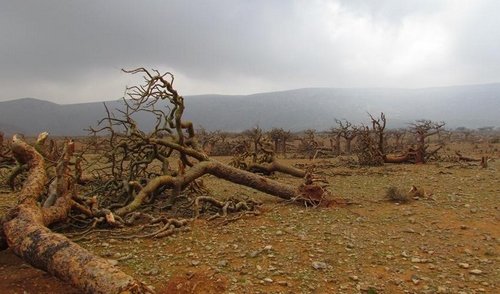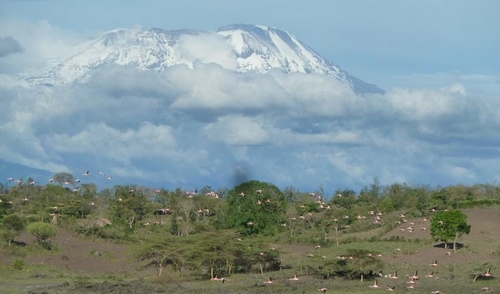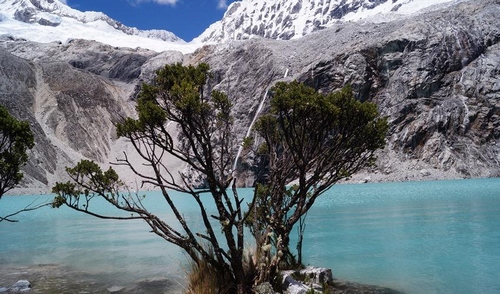Number of natural World Heritage sites affected by climate change nearly doubles in three years – IUCN
The number of natural World Heritage sites threatened by climate change has grown from 35 to 62 in just three years, with climate change being the fastest growing threat they face, according to a report released today by IUCN, International Union for Conservation of Nature, at the UN climate change conference in Bonn, Germany.

Socotra Archipelago, Yemen was hit cyclones in 2015 - a rare weather event in this part of the Indian Ocean.
According to the assessments, climate change impacts, such as coral bleaching and glacier loss, affect a quarter of all sites – compared to one in seven sites in 2014 – and place coral reefs and glaciers among the most threatened ecosystems. Other ecosystems, such as wetlands, low-lying deltas, permafrost and fire sensitive ecosystems are also affected. The report warns that the number of natural World Heritage sites affected by climate change is likely to grow further, as climate change remains the biggest potential threat to natural world heritage.

Kilimanjaro National Park, Tanzania
“Protection of World Heritage sites is an international responsibility of the same governments that have signed up to the Paris Agreement,” says Inger Andersen, IUCN Director General. “This IUCN report sends a clear message to the delegates gathered here in Bonn: climate change acts fast and is not sparing the finest treasures of our planet. The scale and the pace at which it is damaging our natural heritage underline the need for urgent and ambitious national commitments and actions to implement the Paris Agreement.”

Huascarán National Park, Peru
World Heritage-listed coral reefs, such as the Aldabra Atoll in the Indian Ocean – the world's second-largest coral atoll, the Belize Barrier Reef in the Atlantic – the largest barrier reef in the northern hemisphere, and the Great Barrier Reef – the biggest reef on Earth, have been affected by devastating mass coral bleaching events over the last three years, due to rising sea temperatures. The Great Barrier Reef, for instance, has suffered widespread bleaching, with up to 85% of surveyed reefs impacted in 2016.
Retreating glaciers, also resulting from rising temperatures, threaten sites such as Kilimanjaro National Park – which boasts Africa’s highest peak – and the Swiss Alps Jungfrau-Aletsch – home to the largest Alpine glacier.
“Natural World Heritage sites play a crucial role supporting local economies and livelihoods,” says Tim Badman, Director of IUCN’s World Heritage Programme. “Their destruction can thus have devastating consequences that go beyond their exceptional beauty and natural value. In Peru’s Huascarán National Park, for example, melting glaciers affect water supplies and contaminate water and soil due to the release of heavy metals previously trapped under ice. This adds to the urgency of our challenge to protect these places.”
The broader findings of the report show further challenges to World Heritage. Other threats, such as invasive species, unsustainable tourism or infrastructure development, are also increasing. They affect ecological processes and threaten the survival of species within the sites. Invasive alien species are the most widespread of all threats. Their impacts are often aggravated by climate change, which facilitates their spread and establishment.
Overall, the report finds that 29% of World Heritage sites face significant concerns and 7% - including the Everglades National Park in the U.S. and Lake Turkana in Kenya – have a critical outlook. Two-thirds of the sites are assessed as likely to be well conserved in the near future, the same overall proportion as in 2014.
The report also reveals that the management of natural World Heritage sites has dropped in quality and effectiveness since 2014, notably due to insufficient funding. Fewer than half of the sites are currently being managed to good standards.
However, the report also includes some success stories, which show tangible, positive impact of effective management. Côte d’Ivoire’s Comoé National Park, for example, has seen the recovery of its elephant and chimpanzee populations thanks to effective management and international support, following political stabilisation in the country. As a result, its conservation outlook has significantly improved over the last three years. It is one of 14 sites with an improved rating since the 2014 IUCN World Heritage Outlook report.
Source: International Union for Conservation of Nature
- 394 reads
Human Rights
Ringing FOWPAL’s Peace Bell for the World:Nobel Peace Prize Laureates’ Visions and Actions

Protecting the World’s Cultural Diversity for a Sustainable Future

The Peace Bell Resonates at the 27th Eurasian Economic Summit

Declaration of World Day of the Power of Hope Endorsed by People in 158 Nations

Puppet Show I International Friendship Day 2020

